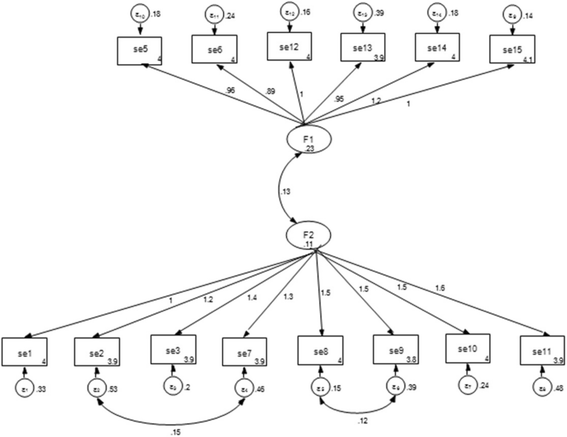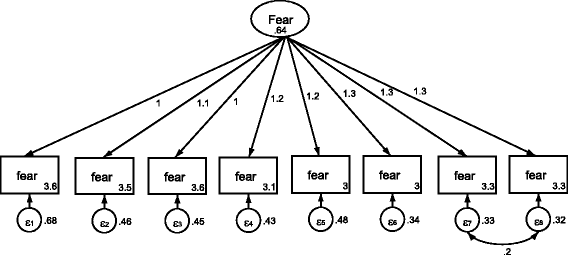Psychometric properties of the mammography self-efficacy and fear of breast cancer scales in Iranian women
- PMID: 28569149
- PMCID: PMC5452424
- DOI: 10.1186/s12889-017-4404-7
Psychometric properties of the mammography self-efficacy and fear of breast cancer scales in Iranian women
Abstract
Background: Research investigating mammography screening has often reported low mammography self-efficacy and breast cancer fear contribute to underutilization of mammography. This study aimed to examine the reliability and validity of Champion's Mammography Self-efficacy Scale (CMSS) and Champion's Breast Cancer Fear Scale (CBCFS) in a sample of Iranian women.
Methods: The adapted instruments were administered to a community sample of 482 women aged 40 years or older. They inhibited in Sanandaj, Iran. Cronbach's α coefficients, item-total, and test-retest correlations were used to assess the reliability of the scales. Confirmatory factor analysis was applied to assess construct validity.
Results: The α coefficients for the Farsi 14-item CMSS and 8-item BCFS were .87 and.95, respectively. In terms of the CMSS confirmatory factor analysis, the proportion of x 2/df was 2.4, Comparative Fit Index (CFI) = 0.93, Tucker Lewis Index (TLI) = 0.96 providing a strong fit to the data induced by two-factor model. With regard to CBCFS, x 2/df was 86.33, CFI =0.99, and TLI =0.99 supporting one-factor model.
Conclusion: The CMSS and CBCFS exhibited strong initial psychometric properties; therefore, they are recommended to understand women's breast cancer screening behaviors better.
Keywords: Breast cancer fear; Iranian women; Mammography; Psychometric properties; Self-efficacy.
Figures


Similar articles
-
Mammography Self-efficacy Scale and Breast Cancer Fear Scale: Psychometric Properties of the Arabic Versions Among Saudi Women.Cancer Nurs. 2021 Mar-Apr 01;44(2):163-170. doi: 10.1097/NCC.0000000000000767. Cancer Nurs. 2021. PMID: 31652134
-
Mammography self-efficacy scale and breast cancer fear scale: psychometric testing of the Turkish versions.Cancer Nurs. 2012 Sep-Oct;35(5):365-73. doi: 10.1097/NCC.0b013e3182331a9a. Cancer Nurs. 2012. PMID: 21946901
-
Validation of the Farsi version of the medical outcomes study-social support survey for mammography.BMC Public Health. 2018 Nov 20;18(1):1280. doi: 10.1186/s12889-018-6174-2. BMC Public Health. 2018. PMID: 30458735 Free PMC article.
-
Determinants of mammography screening in Iranian women: A systematic review and meta-analysis.Breast Dis. 2022;41(1):279-294. doi: 10.3233/BD-210037. Breast Dis. 2022. PMID: 35634841
-
Exploring breast cancer screening fear through a psychosocial lens.Eur J Cancer Prev. 2025 Jan 1;34(1):76-80. doi: 10.1097/CEJ.0000000000000895. Epub 2024 May 15. Eur J Cancer Prev. 2025. PMID: 38747305 Review.
Cited by
-
Psychometric Validation of the Bangla Version of the Breast Cancer Fear Scale Among Female University Students in Bangladesh.Int J Breast Cancer. 2025 Apr 22;2025:6811105. doi: 10.1155/ijbc/6811105. eCollection 2025. Int J Breast Cancer. 2025. PMID: 40309312 Free PMC article.
-
Understanding Fear of Breast Cancer Among Ghanaian Women via the Champion Breast Cancer Fear Scale.Breast Cancer (Auckl). 2025 Jun 28;19:11782234251353270. doi: 10.1177/11782234251353270. eCollection 2025. Breast Cancer (Auckl). 2025. PMID: 40585188 Free PMC article.
-
Fear of breast cancer among young Spanish women: Factor structure and psychometric properties of the Champion breast cancer fear scale.PLoS One. 2021 Apr 5;16(4):e0249562. doi: 10.1371/journal.pone.0249562. eCollection 2021. PLoS One. 2021. PMID: 33819298 Free PMC article.
-
Factors Associated with Mammography Screening Among Women Living in Rural Areas.Florence Nightingale J Nurs. 2022 Jun;30(2):146-153. doi: 10.54614/FNJN.2022.21039. Florence Nightingale J Nurs. 2022. PMID: 35699632 Free PMC article.
-
Predictive Power of PEN-3 Model Constructs in Breast Cancer Screening Behaviors among Teachers: A Cross- Sectional Study in Central Iran.Eur J Breast Health. 2019 Apr 1;15(2):105-110. doi: 10.5152/ejbh.2019.4417. eCollection 2019 Apr. Eur J Breast Health. 2019. PMID: 31001612 Free PMC article.
References
-
- Medicare Cf, Services M. Cancer prevention and treatment demonstration for ethnic and racial minorities. Retrieved June. 2008.
MeSH terms
LinkOut - more resources
Full Text Sources
Other Literature Sources
Medical
Miscellaneous

